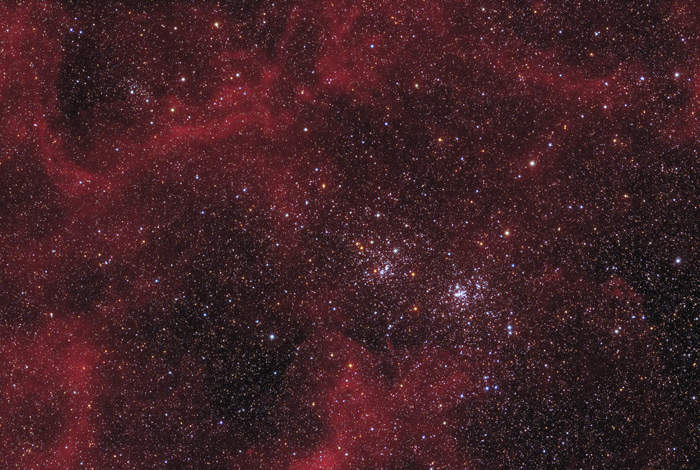
click here for a 75% size 2990x1980 (4342KB)
Click on the images below to find the LRGB image at 40% and 70% (right) and the 22 hour Halpha image at 40% and 70% (left)

| Optics | TeleVue NP101is f5.4 |
| Camera | STL11000M |
| Filters | Baader HALRGB |
| Date | October 2011 |
| Location | Antares Observatory |
| Sky Conditions | mag 5 sky |
| Exposure | LRGB = 22,1.15,1,1,1.15h total: 26.3h |
| Programs used | CCD Stack, Registar, PixInsight, Photoshop CS4 |
These two star clusters are very famous objects among visual astronomers and astrphotographers. Even under moderately
dark skies, the double cluster in the constellation of Perseus is easily seen with the naked eye. Astronomers
number its age to a few million years, i.e. a relatively young cluster. The absolute separation between NGC869 and
NGC884 is only a few 100 lightyears while their light travels for about 7600 years until it reaches the Earth.
About 4 degrees further North, you will find the area of the
Heart and Soul Nebula (IC1805/IC1848), an extended region of strong Ha emission and also a popular target for
astrophotographers. Due to the small angluar distance between those nebulas and the double cluster, I was wondering
if there is any faint Ha emission in the background of NGC869 and NGC884, or at least in the close neighborhood.
A single 20min exposure through a 7nm Halpha filter was not very promising. However, after integrating and heavily stretching
about 3 hours of Halpha data, some parts of the nebula started to get visible. The resulting image using 22 hours of
Halpha data is shown if you click on the thumbnail just to the right.
Additional Luminance and RGB images (4.3 hours in total) were taken for a color image of this rich star field (image
on the far right). The image on the top then shows the result of combining the narrowband and the LRGB color image.
The Halpha line was integrated so that the luminance and the red channel were enhanced.

click here for a 75% size 2990x1980 (4342KB)
Click on the images below to find the LRGB image at 40% and 70% (right) and the 22 hour Halpha image at 40% and 70% (left)